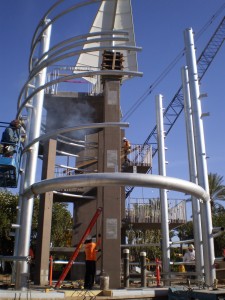17 Dec 2012
RSS
Blog posts tagged with 'bending HSS'
27 Apr 2007
How HSS reacts to the bending process
Without some sort of internal support HSS material rolled / curved will result in a certain level of distortion. The faces of the material will try to concave, wrinkle and crush during the bending process. HSS reacts to the bending process by collapsing inward as a result of compression across the horizontal faces and the inside face of the material. Severity of deformation is increased when using thinner wall material and/or bending to tighter radii. Deformation of tube faces is also dependant on material sizes and direction of rolling (i.e. the Hard-way or the Easy-way) when bending rectangular tube steel. The inside face will deform more significantly when bending rectangular material the Easy-way versus the Hard-way. The outside face of the material will always deform the least regardless of bend direction. In extreme cases, certain faces may not only collapse inward, but can result in alternating inward and outward collapsing as larger wrinkles throughout the bend section. Albina Pipe Bending Co., Inc. has implemented an internal support system that reduces concavity, minimizes distortion, allows for tighter radii and reduced deformation and twist. By filling the void in tube steel’s interior, internal support restricts the amount that material can collapse, resulting in greatly reduced deformation using thinner walls to tighter radii when compared to materials bent without internal support. Internal Support is designed to provide higher quality bends to the end user by meeting your Architecturally Exposed needs. Albina Pipe Bending Co., Inc. feels strongly that bending options must be supplied to an end user. It is critical for end users to understand that increasing the wall thickness is a solution BUT NOT the only solution if you demand high quality HSS bends. It is important to Albina to provide customers with cost effective solutions by providing a number of bending options (i.e. roll bending with or without internal support, cold increment bending and hot increment bending) resulting in various end products.
30 Mar 2007
Bending HSS the easy-way vs. the hard-way
Contrary to what most people think, bending HSS (hollow structural sections) the "hard-way" will frequently result in less concavity (distortion) then bending the same size of material the "easy-way".
Bending the hard-way simply means that the steel member is being bent around/against the "strong-axis".
Bending the easy-way simply means that the steel member is being bent around/against the "weak-axis".
When bending the easy-way, the greater difference between the sides of the tubing will result in greater distortion (less concavity on the inside of the bend). For instance, TS 8" x 2" (a difference of 6”) will have less concavity on the inside of the bend than TS 16" x 4" (a difference of 12").
When bending either the easy-way or hard-way concavity may become less of a problem if the wall thicknesses of the material are increased. For example, TS 12" x 6" x .250" wall material bent the easy-way will result in more concavity (distortion) then TS 12" x 6" x .375" wall bent to the same radius.
Bending companies, like Albina Pipe Bending Co., Inc. implement various techniques to minimize concavity (distortion) when bending HSS material the easy-way and when bending the hard-way. These techniques include but aren’t limited to: bending style (roll, increment, hot, etc), tooling, internal support systems, etc.
It is critical that the end user states their distortion requirements (i.e. what does the material need to look like after it is bent) prior to receiving a quote for bent HSS. By discussing your distortion requirements early in the process, before a quotation is issued, bending companies like Albina Pipe Bending Co., Inc. are able to provide accurate quotations representative of what end users require.
Bending the hard-way simply means that the steel member is being bent around/against the "strong-axis".
Bending the easy-way simply means that the steel member is being bent around/against the "weak-axis".
When bending the easy-way, the greater difference between the sides of the tubing will result in greater distortion (less concavity on the inside of the bend). For instance, TS 8" x 2" (a difference of 6”) will have less concavity on the inside of the bend than TS 16" x 4" (a difference of 12").
When bending either the easy-way or hard-way concavity may become less of a problem if the wall thicknesses of the material are increased. For example, TS 12" x 6" x .250" wall material bent the easy-way will result in more concavity (distortion) then TS 12" x 6" x .375" wall bent to the same radius.
Bending companies, like Albina Pipe Bending Co., Inc. implement various techniques to minimize concavity (distortion) when bending HSS material the easy-way and when bending the hard-way. These techniques include but aren’t limited to: bending style (roll, increment, hot, etc), tooling, internal support systems, etc.
It is critical that the end user states their distortion requirements (i.e. what does the material need to look like after it is bent) prior to receiving a quote for bent HSS. By discussing your distortion requirements early in the process, before a quotation is issued, bending companies like Albina Pipe Bending Co., Inc. are able to provide accurate quotations representative of what end users require.
Blog search
Blog archive
- 2025
- 2024
- 2023
- 2022
- 2021
- 2020
- 2019
- 2018
- 2017
- 2016
- 2015
- 2014
- 2013
- 2012
- 2010
- 2009
- 2008
- 2007

